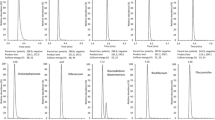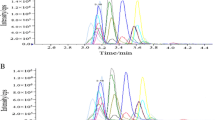Abstract
The detection of 4-hydroxycoumarin rodenticides in poisoned domestic animals requires a highly sensitive method as tissue and serum levels of anticoagulants may be very low owing to rapid elimination, metabolism or post-mortem degradation. Thin-layer chromatography (TLC) and reversed-phase high-performance liquid chromatography (RP-HPLC) with fluorescence detection were used to identify the anticoagulants in spiked tissues and in suspicious samples. The analysis of ten suspicious samples highlighted the limitations of both methods. Only the three samples of baits were found positive by TLC whereas one of the five anticoagulants was detected in eight samples by RP-HPLC with fluorescence detection. Therefore, RP-HPLC with fluorescence detection proved to be the more sensitive method for detecting low levels of 4-hydroxycoumarins in blood serum, liver and ingesta, whereas TLC is usually sufficient for analysing baits.
Similar content being viewed by others
Abbreviations
- RP-HPLC:
-
reversed-phase high-performance liquid chromatography
- TLC:
-
thin-layer chromatography
References
Booth, N.H. and McDonald, L.E., 1988.Veterinary Pharmacology and Therapeutics, 6th edn, (Iowa State University Press, Ames)
Egan, D.A. and O'Kennedy, R., 1992. Rapid and sensitive determination of coumarin and 7-hydroxycoumarin and its glucuronide conjugate in urine and plasma by high-performance liquid chromatography.Journal of Chromatography,582, 137–143
Felice, L.J., Chalermachaikit, T. and Murphy, M.J., 1991. Multicomponent determination of 4-hydroxycoumarin anticoagulant rodenticides in blood serum by liquid chromatography with fluorescence detection.Journal of Analytical Toxicology,15, 126–128
Hunter, K., 1983. Determination of coumarin anticoagulant rodenticide residues in animal tissue by high-performance liquid chromatography.Journal of Chromatography,270, 267–276
Hunter, K., 1985. High-performance liquid chromatographic strategies for the determination and confirmation of anticoagulant rodenticide residues in animal tissues.Journal of Chromatography,321, 255–272
Nahas, K., 1986. Dosage de la bromadiolone (rodenticide anticoagulant) dans le plasma, le foie et le rein du rat.Journal of Chromatography,369, 445–448
Author information
Authors and Affiliations
Rights and permissions
About this article
Cite this article
Rengel, I., Friedrich, A. Detection of anticoagulant rodenticides (4-hydroxycoumarins) by thin-layer chromatography and reversed-phase high-performance liquid chromatography with fluorescence detection. Vet Res Commun 17, 421–427 (1993). https://doi.org/10.1007/BF01839210
Accepted:
Issue Date:
DOI: https://doi.org/10.1007/BF01839210




